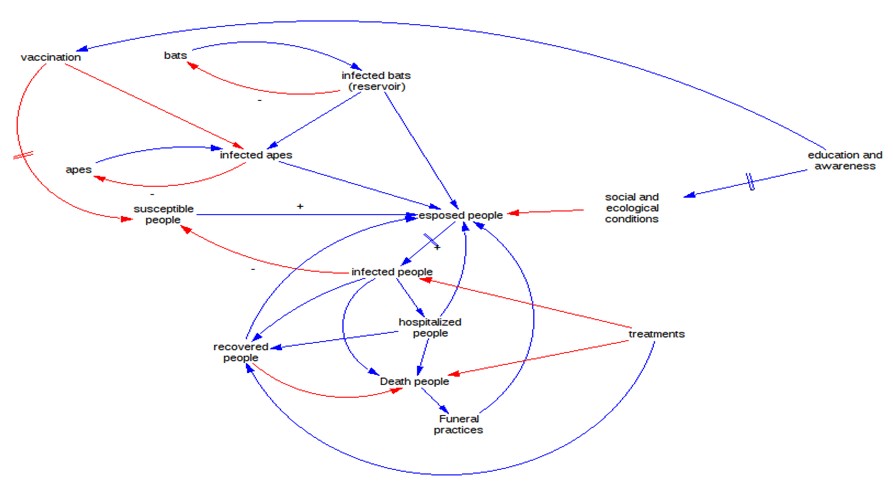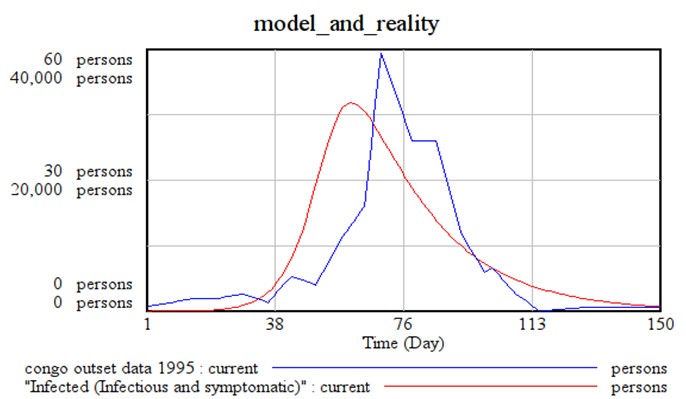Modelling the Ebola Crisis with System Dynamics
Giuseppe Noce
nocegius@yahoo.it
Humans have been acquiring infective diseases from animals (zoonoses), since the first human appeared on Earth. We estimate that 60% of human infective diseases originate in animals. Ebola Disease is one of those diseases. Animals (such as fruit bats) carry the Ebola virus and could transmit it into apes and humans. In March 2014, the largest and most complex Ebola outbreak started. In the beginning, it involved Guinea then spread across land borders to Sierra Leone, Liberia and Senegal, and to Nigeria by air. Few suspected outbreaks have been reported out of Africa Countries. To face the Ebola Crisis, UN declared it as a threat to world peace and security. For WHO, Ebola was a Public Health Emergency of International Concern.
To address the Ebola Crisis a valid System Dynamic (SD) model is created. At the beginning a casual loop diagram is developed (fig 1).
 Fig 1 – The casual loop of the Ebola Crisis, in red, negative feed back effect
Fig 1 – The casual loop of the Ebola Crisis, in red, negative feed back effect
The kernel represents the progression of people through the dynamic of the Ebola disease system. Humans are subdivided into six classes. Susceptible are people who could become exposed. Exposed are infected people but not yet infectious. After the incubation period, they become infected, spreading virus and suffering from clinical signs. Infected people may be hospitalized in hospital or in an Ebola Treatment Unit (ETU) where they undergo symptomatic therapy or they are cured by village medicine men (witchdoctors) by way of traditional medicine an stay in their home. Dead infected people spread the virus to other people during their tradition funeral practices. The last group is recovered people, who are immune but spread the virus. They suffer the Post Ebola Syndrome. This structure is similar to the epidemiological SEIR model, with two classes (Hospitalized people and Funeral practices) added.
So far, animal reservoirs of this virus elude scientists. However, reservoirs are able to suggest strategies to prevent or mitigate outbreak, so interactions with them are suspected and added into the model. Social and economic aspects of the Ebola Crisis are also added. The model is fitted with real data of Ebola disease in Congo in the 1995 (fig. 2).
 Fig. 2 – The comparation between reality (congo ouset data 1995) and the model simulation (“Infected (infectious and symptomatic)”)
Fig. 2 – The comparation between reality (congo ouset data 1995) and the model simulation (“Infected (infectious and symptomatic)”)
To evaluate the impact of the control measures on the outbreak, a scenario analysis is performed. Hypothetical vaccine and pharmaceutical intervention are modelled and examined. We simulated the effectiveness of the isolation and quarantine of the exposed or infected people. We also simulated educational and awareness programs effects. The simulation results show that educational and awareness programs have an higher impact to reduce and mitigate Ebola Disease damages. By the model, we show that individual and community health education increase awareness and ownership. So people change behaviour and thinking. People cook well (over 100° C) ape and bat meat, perform funeral in a safety way avoiding to touch dead body without protective clothes (PE). Hospital staff is well trained and use PE. Awareness reduces the stigma and the infections fear. Hospitals and ETUs become a good places in which go to cure themselves and the rate of people recovered in hospital or ETUs rises. The simulation shows that when all people upgrade their knowledge, Ebola virus will not spread. Educational and awareness programs seem to have a major effects than vaccination.
The Ebola Crisis is still a problem of International Community. But, so far, the Ebola Crisis has been managed as usual, by a mere additive linear and reduction approach. Inextricable relationship between causes and effects has not been examined.
We need to recognise that we live in an interconnected world and that the solutions cross all sectors of human society. We need to recognise that zoonoses cross the wildlife, humans and domestic animals. Transdisciplinary becomes necessary to understand and study mechanisms of zoonoses One Health (www.oneworldonehealth.org) concept is developed to take on zoonoses because refers to an interdisciplinary, cross sectoral approach towards human, animal and environment health. SD models integrate non linear relationships, feedback structures over time as well as qualitative and quantitative data. SD models represent a bridge among competences and are able to build the most realistic representation of the reality.
One Health approach can be useful modelled by SD models.
The proposal SD model shows the dynamic interdependency among key factors that govern the Ebola Crisis and allows us to identify the potential intervention key points where preventive and mitigating measures could be effectively applied.
Sources:
Anderson, R. M. & May, R. M. (1991). Infectious Diseases of Humans. Oxford: Oxford University Press.
Bailey NTJ (1975) The mathematical theory of infectious diseases and its applications London:Griffin
Homer RJ & Hirsch G (2006) System Dynamics Modelling for Public Health: Background and Opportunities. American Journal of Public Health, 96(3). 452-458
Rivers CM, Lofgren ET, Marathe M, Eubank S, Lewis BT (2014) Modeling the Impact of Interventions on an Epidemic of Ebola in Sierra Leone and Liberia Cornell University Library http://arxiv.org/abs/1409.4607
Sterman JD Business (2000) Dynamics: Systems Thinking and Modelling for a Complex World McGraw-Hill
Vazquez M, Liz M, Aracil J (1996) Knowledge and reality:some conceptual issues in system dinamics modeling System Dynamics Review, 12(1), 21-37